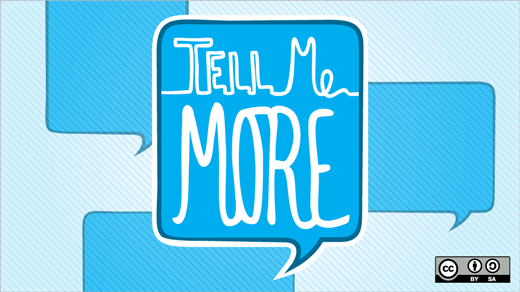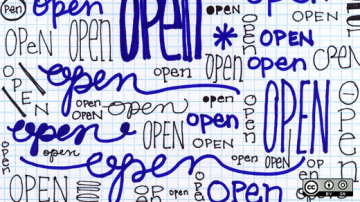In the second part of my interview with Sam Knuth, a fellow Open Organization Ambassador, we discussed how leaders can identify areas for coaching open management practices within their organization to ensure the managers they lead are letting open values guide their work teams and associates. It takes emotional intelligence—and effort.
To wrap our time together, Sam and I discussed understanding and showing vulnerability with others in the workplace. Sam has authored articles on this important topic for Opensource.com, and his stories about life as an open leader showcase a passion for those (and other) open values. In this interview, we discuss the benefits of leaders showing vulnerability.
Opening up
A number of articles and authors have shed light on the leadership practice of being vulnerable and its benefits. We usually think of sharing our vulnerability only in our personal lives but, in fact, this has been a popular leadership topic for some time, and studies have shown that showing vulnerability in the workplace also has benefits.
One benefit is that it can build trustful relationships. People seem to intuitively understand when another person is being authentic and sharing something either scary or heartfelt and tend to respond with compassion. And yet Sam also wholeheartedly recognizes that managers benefit from some degree of privilege in being able to share and be vulnerable; implicit or explicit power dynamics might discourage individual contributors from responding honestly to them. So if leaders model vulnerability, they can normalize the practice to the benefit of others—decreasing not only the stigma associated with it but also the negative consequences of sharing. In this way, vulnerability has another benefit: as a researcher of creativity, I know creativity isn't possible without vulnerability, because sharing a creative idea is tied to the risk of criticism, rejection, and failure—just like vulnerability. There is no creativity or innovation without risk of this kind.
My interview with Sam focused on understanding the need to be vulnerable as a leader. How can decision-makers share vulnerability, why, and what are the benefits?
Three facets of vulnerability
Sam described three facets of vulnerability, and teasing these apart highlighted differences in levels of psychological safety, risk tolerance, and accountability.
First, vulnerability can involve taking responsibility for a mistake and adjusting accordingly, but leaders who are decision-makers have an added mandate to think about: seeing the mistake from other people's perspectives. When decision-making leaders make mistakes, the burden of their mistake is felt more broadly across teams, potentially even an entire organization. Taking responsibility in this context can mean owning the mistake across a large number of associates, and doing so creates trust in the leader. Responsibility doesn't end there, however; leaders need to learn from their mistakes too—learn how to get feedback and be more inclusive in their decision making. Contrary to what one might want to do (run away and hide from mistakes!), talking more about mistakes within the organization helps understanding, improves trust building, and highlights where the pockets of dissension and agreement are. Taking responsibility and learning to make more open decisions will add up to making less mistakes in the future.
Listen to Sam Knuth explain the power of being open about your mistakes
The second dimension of vulnerability involves leaders sharing how they are feeling, their fears, concerns; it's much deeper, more emotional and personal. It can reveal a lack of confidence, nervousness, fears, and, in Sam's case (since he's shared his experience with anxiety), details of his mental health. Like me, Sam has found that most people see and relate to authenticity and are empathetic rather than critical when they encounter someone vulnerable. When leaders share themselves in this deeply personal way, others can better understand them and be more inclusive of how they work. This not only helps teammates better understand how they can approach, communicate with, and relate to one another, but also helps normalize discussions of mental health in the workplace. Sam's sharing in the workplace has made others more comfortable leaning into their own ability to be vulnerable (I recently shared with my manager some difficulties I have with anxiety, which helped her know how to best support me so that I could thrive in my role).
But it's important to realize how power differentials impact different people's ability to be vulnerable. Sam believes that managers need to do more to create safe spaces for vulnerable discussions. That might be in team meetings or one-on-ones to discuss the topic, or by sharing articles on the topic to indicate to everyone that you are aware of and sensitive to the personal challenges people may be facing. Activities like these open the door for associates to trust managers and be vulnerable in turn.
Sam's third facet of vulnerability is saying "I don't know," a phrase that becomes harder to say the more decision-making a leader is responsible for. But Sam points out that it's better to say "I don't know" than something that sounds good but is hollow (which erodes trust). In conventional organizations, sharing "I don't know" can be seen to reveal an uncertainty or lack of clarity or vision. Although these are often viewed as foundational necessities for a leader, open leaders find ways to act inclusively, discussing the problem and empowering the community to solve it, rather than rely solely on their own vision and authority to find and implement solutions.
For me, Sam's vulnerability and authenticity encouraged me to share my own issues with workplace anxiety with my current manager, especially since the COVID-19 pandemic triggered deep-seated fears based on childhood trauma (thankfully, my manager has been very understanding and supportive). But being more vulnerable—as an individual contributor or a minority—can prevent people from actively rising into or even aspiring to leadership roles if they're seen as weak, emotional, "broken," etc. Sam hopes this is changing.
"The risks are real," he says. "I'd love to say that everyone should feel safe and comfortable coming forward with this kind of vulnerability, but I don't think as a society we're there yet."
The future of workplace vulnerability
Things are changing, though. More business-press articles are being published on vulnerability, as well as books, podcasts, and other resources. When leaders are vulnerable, they experience many benefits. People may comment or open up in similar ways and psychological safety increases for the whole group, enabling greater understanding about a context or situation, creating closer connections and stronger relationships with others.
Because many managers set examples for desirable workplace behavior, it's important that they take the first step in being vulnerable and allowing vulnerability to become part of discussions and work activities. They can do this in many ways: team meetings, resources, one-on-one meetings, or indicating that they are open, aware, and sensitive to the personal challenges people may be facing.
From my perspective as an innovation researcher, I'd suggest that vulnerability takes inclusivity to the "next level," the level that enables the creative self to find true meaning in the work we do. Vulnerability means we include our creative selves.
True innovation is always risky. It's a state of not knowing whether an idea will solve a problem, a need for that idea to be accepted or chosen, or a risk that the idea could be criticized and ridiculed. Without vulnerability, we lose the creative opportunity to truly innovate—always existing in potential, and never realization.







Comments are closed.